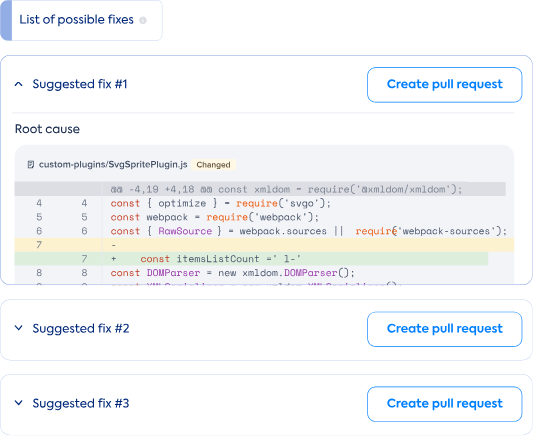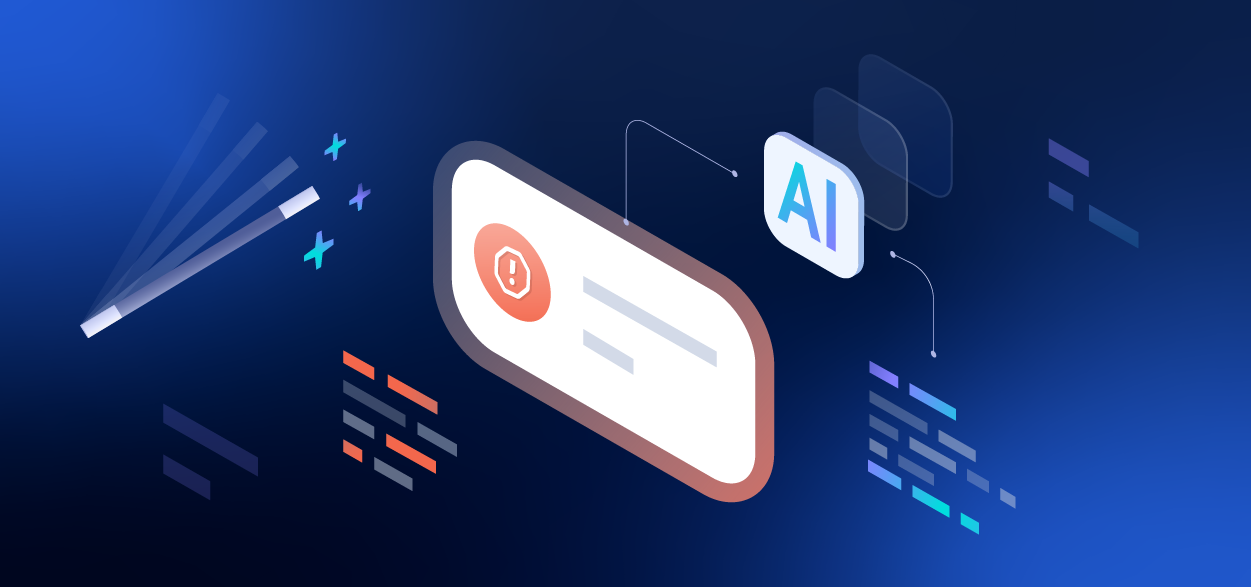Every mobile developer knows the drill: you're deep in building a new feature when a crash alert hits your Slack channel. Within minutes, you're pulled away from productive work to hunt through stack traces, attempt reproduction, research similar issues, and finally code a fix. This reactive cycle consumes an enormous amount of development time, with industry research showing that 48% of developers lose 5-7 hours a week and 11% lose more than 9 hours a week on maintaining app quality rather than building features.
Traditional observability tools excel at showing you what's going wrong with your app. They provide comprehensive dashboards, detailed crash reports, and performance metrics. But here's the problem: knowing what's wrong is only half the battle. The real bottleneck isn't collecting data; it's the manual process of turning that data into insights, and those insights into action.
This is where AI observability represents a fundamental shift from passive monitoring to active problem-solving. Instead of simply alerting you to issues, AI observability platforms can automatically analyze root causes, predict problems before they impact users, and even generate code fixes. A growing number of development teams are realizing that when you combine artificial intelligence with traditional observability, something remarkable happens: apps begin to fix themselves.
Let's look at how AI observability tackles the three biggest time sinks in mobile quality management—debugging crashes, analyzing performance issues, and catching user experience problems—and what this means for your development workflow.
Traditional crash resolution follows a predictable, time-consuming workflow. Developers must shift context from feature work to forensic analysis, triaging the most severe issues, manually parsing stack traces, attempting to reproduce the issue, researching similar problems, and finally implementing a fix. Each step requires human intervention and can take hours or even days to complete.
AI observability fundamentally changes this process by performing automatic root cause analysis. Instead of manually parsing individual crash reports, the AI analyzes patterns across thousands of crash occurrences to identify the underlying cause. These systems can spot subtle correlations that would take human developers much longer to discover—connections between specific device configurations, user actions, or code paths that consistently lead to failures.
The most advanced AI observability platforms can even generate code fixes automatically. By understanding the crash pattern and having access to your codebase, AI can propose specific solutions and create pull requests that integrate with your existing development workflow. What once took hours of detective work can be reduced to a simple code review and merge.
Consider a null pointer exception that affects users on specific Android versions. Traditional debugging might involve reproducing the crash on test devices, analyzing logs, and researching the Android documentation. Now, AI observability could instantly identify the pattern, understand that the issue occurs when a particular API returns null on those OS versions, and generate a fix with proper null checking—all without human intervention in the analysis phase.
It’s common for performance alerts to flood dashboards without providing meaningful context about why app launch times spiked or why certain screens are loading slowly. Developers spend countless hours manually correlating data between network calls, screen loads, user flows, and device characteristics to understand performance degradation.
AI observability excels at automatically connecting performance issues to their root causes. These systems can analyze patterns across millions of user sessions to identify that performance problems correlate with specific code changes, affect particular user segments, or manifest only under certain device configurations. This automated correlation eliminates the manual detective work that typically consumes developer time.
More importantly, AI-powered performance monitoring can be predictive rather than reactive. By analyzing historical patterns and current trends, these systems can identify performance degradation before it significantly impacts users. Instead of discovering a problem after user complaints, AI observability can alert teams to emerging issues while they're still manageable.
This predictive capability extends to capacity planning and release management, too. AI can analyze how new features or code changes affect performance metrics, providing early warnings about potential issues before they reach production at scale.
Traditional observability tools excel at capturing hard metrics like crashes and performance data, but they often miss the "soft" quality issues that significantly impact user experience. UI misalignments, broken layouts, design inconsistencies, and other visual problems rarely generate alerts, yet these paper-cut issues contribute significantly to user frustration and poor app store ratings.
AI-powered visual detection represents a breakthrough in catching these subtle quality issues. Computer vision systems can automatically scan app interfaces to identify visual problems that would typically require manual testing to discover. These systems can spot misaligned text, improperly cropped images, color inconsistencies, or layout issues across different device sizes and configurations.
Beyond visual detection, AI observability can also analyze user behavior patterns to identify frustration signals that traditional metrics miss. By processing session replay data and user interaction patterns, AI can identify sequences of actions that consistently lead to user frustration—rapid tapping, frequent app switching, or repeated attempts at the same action. These behavioral signals often precede negative app reviews and can highlight usability issues that don't manifest as traditional bugs.
This proactive approach to user experience management allows devs to address quality issues before they impact user satisfaction at scale. Instead of responding to negative reviews or user complaints, teams can identify and resolve experience problems during development or shortly after release.
Remember how much of mobile development time and effort typically goes toward maintaining app quality? AI observability has the potential to dramatically reduce this burden, freeing up significant capacity for feature development.
Developers can focus more energy on building features that drive business growth rather than reactive firefighting. Better app quality leads to improved user satisfaction, higher app store ratings, higher revenue per user, and reduced support burden. The compound effect creates a positive cycle where quality improvements enable faster feature development, which in turn drives better business outcomes.
This transformation can give your team a real competitive edge. Using AI observability, teams can ship features faster while keeping quality high. When app quality directly affects whether users stick around or delete your app, that advantage matters more than ever.
While the concept of self-healing apps might sound futuristic, AI observability tools are available today and being adopted by leading mobile teams worldwide. The key is starting with a platform that integrates AI capabilities natively rather than trying to retrofit traditional monitoring tools with AI features.
Instabug represents the current state-of-the-art in AI-powered mobile observability. As a mobile-first platform, Instabug has built AI capabilities specifically for the unique challenges of mobile app development. Instabug's SmartResolve feature exemplifies the potential of AI observability, automatically analyzing crashes and generating code fixes that integrate directly with development workflows.

With over 25,000 mobile teams and presence on 4+ billion devices, Instabug has proven that AI observability can scale to enterprise requirements while maintaining the reliability that mission-critical applications demand. The platform covers the complete spectrum of mobile quality, from automated crash resolution to predictive performance monitoring to intelligent user experience analysis.
The question isn't whether AI will transform mobile app quality management; it's whether your team will be among the early adopters who gain the competitive advantage, or among those playing catch-up later.
Learn more:
- The Benefits of Observability for Mobile App Developers
- The Difference Between Mobile Observability and Mobile Monitoring
- The Importance of Mobile Observability In User Experience
- Stop Treating Mobile Apps Like Web Apps
Instabug empowers mobile teams to maintain industry-leading apps with mobile-focused, user-centric stability and performance monitoring.
Visit our sandbox or book a demo to see how Instabug can help your app









